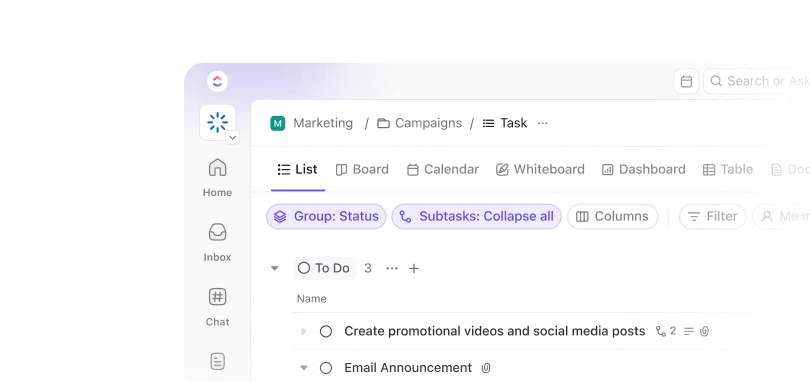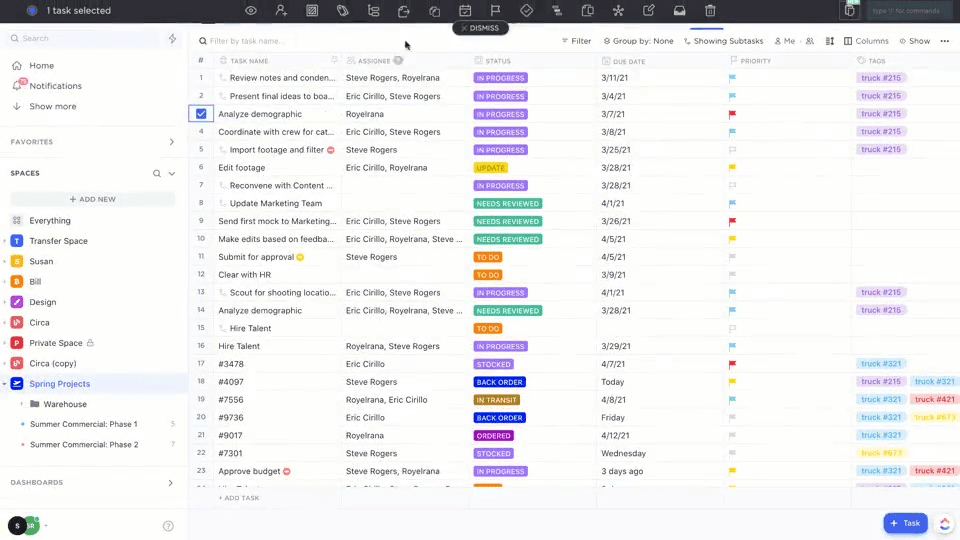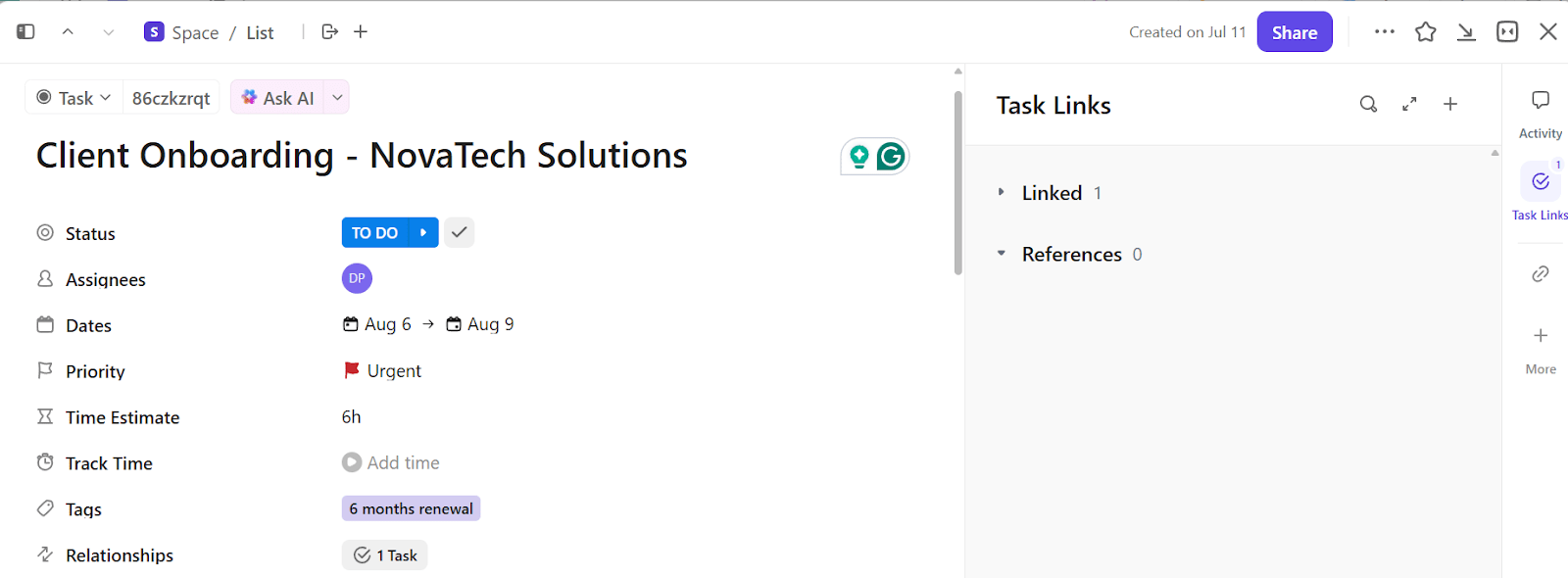When multiple teams touch the same data, chaos spreads fast. Marketing logs leads one way, while sales logs them another. Ops adds new tags. Dev updates the schema. Suddenly, no one knows which version is the correct one.
That’s where great database builder software comes in—it lets you collect, store, and sync data across teams while keeping it clean, connected, and usable.
In this post, we’ve rounded up 11 of the best database builders to help you keep collaboration smooth, structure consistent, and data crystal clear—no matter how many hands are on deck. 🤝
- Top Database Builder Software at a Glance
- What Should You Look for In Database Builder Software?
- The Best Database Builder Software
- How we review software at ClickUp
- 1. ClickUp (Best for all-in-one database and project management)
- 2. Google AppSheet (Best no-code builder for Google Workspace users)
- 3. Microsoft SQL Server (Best for enterprise-level relational database management)
- 4. Microsoft Access (Best for desktop database creation and local use)
- 5. Zoho Creator (Best for building scalable business apps quickly)
- 6. Knack (Best for building simple online databases without code)
- 7. Caspio (Best for low-code app development with enterprise compliance)
- 8. Zapier (Best automation platform for connecting apps and workflows)
- 9. Tadabase (Best for building complex, data-driven web apps)
- 10. PostgreSQL (Best open-source relational database for advanced SQL use)
- 11. Airtable (Best for blending spreadsheets with relational databases)
- Build a Strong (Data) Base With ClickUp
Top Database Builder Software at a Glance
These are the top options for database builder software compared.
| Tool | Best for | Best features | Pricing |
|---|---|---|---|
| ClickUp | All‑in‑one database and project management Team size: Individuals & teams of all sizes | Tasks as records, Custom Fields, Table View, Automations, Dashboards, ClickUp Brain | Free forever; Customizations available for enterprises |
| Google AppSheet | No‑code app building inside Google Workspace Team size: Individuals to mid‑sized firms | Drag-and-drop logic, Google Sheets database integration, offline sync, mobile-ready dashboards | Free; From $5/month per user |
| Microsoft SQL Server | Enterprise‑grade relational DBMS Team size: Developers & DB admins | In‑memory OLTP, JSON/graph support, Always On availability | Custom pricing |
| Microsoft Access | Desktop database creation & local use Team size: Small teams & admins | Table wizards, VBA macros, form‑based UI | $179.99/user (one‑time) |
| Zoho Creator | Low‑code business apps with workflow automation Team size: Small to mid‑sized marketing & ops teams | Drag‑&‑drop builder, Deluge scripting, mobile deployment | Free trial; From $12/month per user |
| Knack | Online databases without coding Team size: Individuals, DBAs & small teams | Role‑based permissions, embeddable apps, charts/maps | From $19/month per user |
| Caspio | Low‑code apps with enterprise compliance Team size: Mid‑sized firms & enterprise ops teams | HIPAA/SOC 2‑compliant, REST APIs, point‑&‑click builder | Custom pricing |
| Zapier | Automation platform connecting apps & workflows Team size: Individuals & mid‑sized marketing/ops teams | 6,000+ integrations, multi‑step flows, error handling | Free; From $19/month |
| Tadabase | Build complex web apps fast Team size: Enterprise teams & system admins | Multi‑table layouts, white‑labeling, PDF/email automation | From $50/month per user |
| PostgreSQL | Advanced open‑source SQL engine for large datasets Team size: Mid‑sized to enterprise firms | JSONB/arrays, PostGIS, replication, extensibility | Free (open source) |
| Airtable | Relational spreadsheets with collaboration Team size: Small to mid‑sized product & content teams | Custom views, automations, Slack/Gmail integrations, and internal data visualization tools | Free; From $20/month per user |
What Should You Look for In Database Builder Software?
Here’s a list of what to look for in a free database software:
- Define your data structure easily with customizable fields, tables, and relationships
- Automate repetitive tasks and updates with built-in workflows or integrations
- Visualize your data in multiple formats, like tables, forms, Kanban, or Gantt views
- Control user access with role-based permissions to protect sensitive information
- Scale your database as your team or data complexity grows, without performance issues
- Collaborate in real time with multi-user support and activity tracking
- Onboard new users easily with spreadsheet templates, documentation, and a low learning curve
🔍 Did You Know? The first real computer database appeared in the 1960s, with Charles Bachman’s Integrated Data Store (IDS) often considered the first true DBMS.
The Best Database Builder Software
Does your current system feel more like a workaround? Here are some of the best free project management software tools to create structured, flexible, and scalable systems. 🎯
How we review software at ClickUp
Our editorial team follows a transparent, research-backed, and vendor-neutral process, so you can trust that our recommendations are based on real product value.
Here’s a detailed rundown of how we review software at ClickUp.
1. ClickUp (Best for all-in-one database and project management)
First on our list is ClickUp. It’s the everything app for work that combines project management, knowledge management, and chat—all powered by AI that helps you work faster and smarter.
Combined with the ClickUp CRM Project Management Software, it blends relational database functionality with project execution features. That means you can track contacts like a CRM, build workflows like an ops team, and assign action items like a project manager.
Tasks in ClickUp
Think of ClickUp Tasks as your ‘record’ in database terms. Each task holds a title, description, checklist, files, assignees, and comments.
Let’s say you’re using ClickUp as a client management system. Each client gets a task where you can add a checklist for onboarding steps, upload signed contracts or NDAs, and leave internal notes.
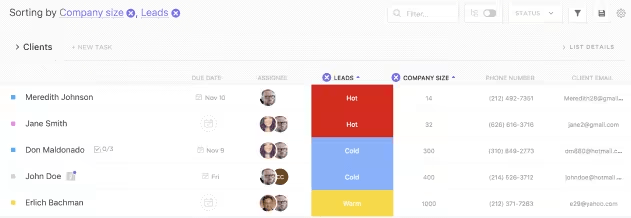
ClickUp Custom Fields is where the platform truly begins to function like a database. You can add dropdowns, dates, phone numbers, checkboxes, URLs, and even calculated fields. These fields create a structure tailored to your needs.
For instance, you’re managing influencer partnerships. For each campaign task, add:
- A custom field for Influencer Tier (e.g., Gold, Silver, Bronze)
- Content Format (Reel, Post, Story)
- Delivery Deadline
- Approval Status with color-coded dropdowns
Dependencies in ClickUp Tasks
Pair this with ClickUp Task Dependencies, and you’ve got control over sequence. All you have to do is set relationships between consecutive tasks, and ClickUp will notify you when overdue tasks affect your timeline.
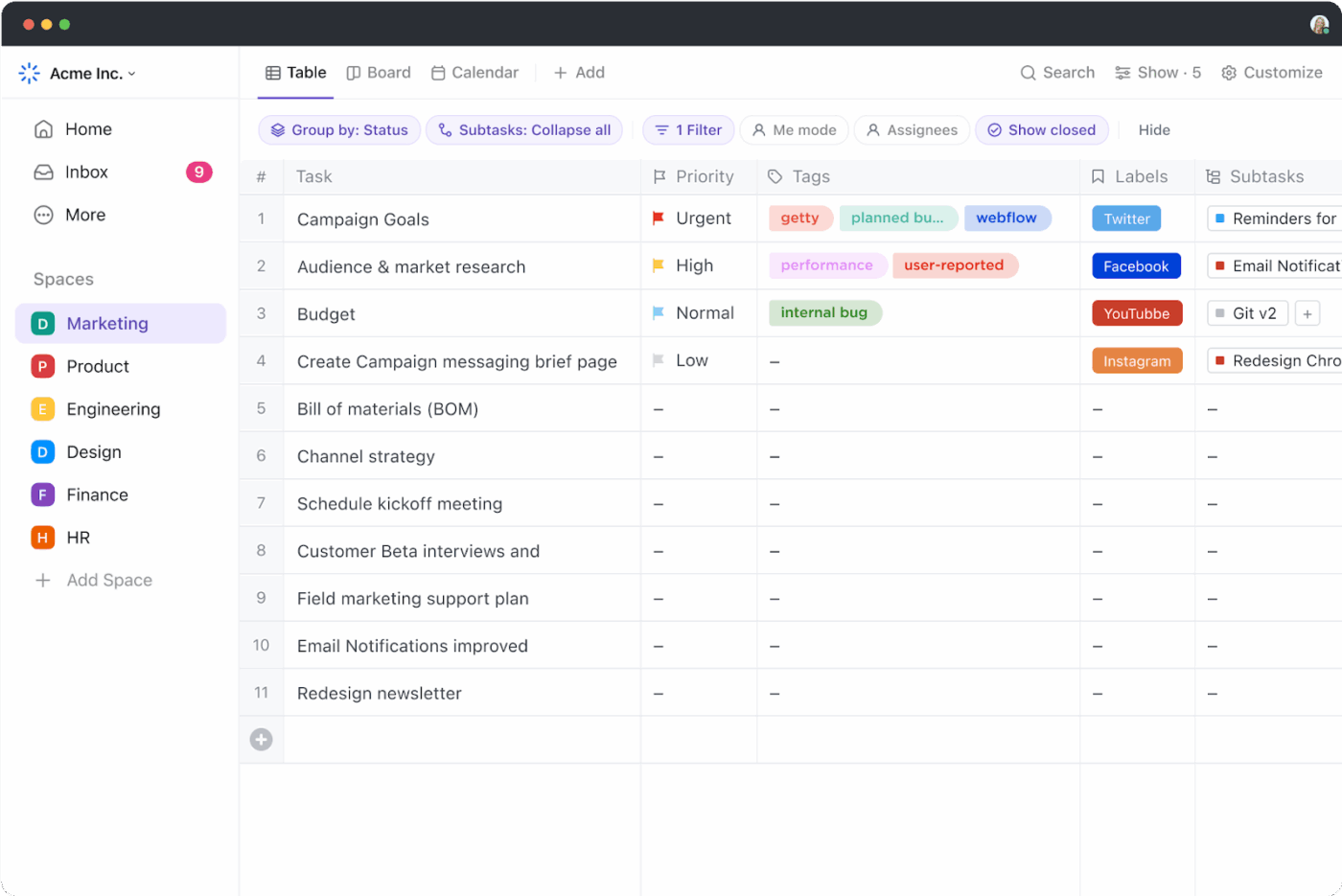
If you live in spreadsheets, the ClickUp Table View will feel pleasantly familiar.
Each row represents a task, and each column corresponds to a field (status, assignee, custom data), with all updates occurring in real-time.
If you’re running a content calendar, you can view article topics by assigned writer and word count, sort by who’s overdue, and add advanced filter options.
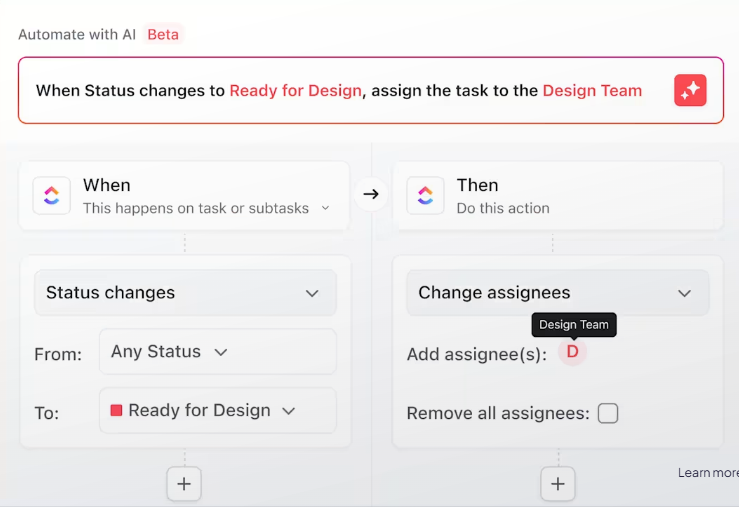
Now, layer in ClickUp Automations, and your workspace starts thinking intelligently. You can create no-code ‘when.. if’ rules.
Say you’re managing customer feedback. Every time someone fills out a feedback form, an automation can assign it to the support team and set the priority based on sentiment analysis.
Building a database is only the first step—keeping it updated is where the real challenge begins.
🎥 In this video, you’ll learn how to automate workflows in just five minutes, so your database stays accurate, your processes stay synced, and your team spends less time on manual updates.
ClickUp best features
- Capture data: Create public or internal surveys to collect client briefs, feature requests, support tickets, or feedback with ClickUp Forms, and let the tool integrate it directly into tasks
- Visualize progress: Track KPIs, sprint velocity, overdue tasks, or customer churn in real time with custom charts, widgets, and time tracking summaries with ClickUp Dashboards
- Work your way: Switch between lists, boards, tables, timelines, or calendars with ClickUp’s customizable views to suit your workflow
- Collaborate seamlessly: Assign tasks, tag teammates in threaded comments, attach docs, and track dependencies for contextual information retrieval
ClickUp limitations
- Steep learning curve due to its extensive features
ClickUp pricing
ClickUp ratings and reviews
- G2: 4.7/5 (10,000+ reviews)
- Capterra: 4.6/5 (4,000+ reviews)
What are real-life users saying about ClickUp?
This G2 review really sums it all up:
📮 ClickUp Insight: 43% of people say repetitive tasks provide helpful structure to their workday, but 48% find them draining and a distraction from meaningful work.
While routine can offer a sense of productivity, it often limits creativity and holds you back from making meaningful progress.
ClickUp helps you break free from this cycle by automating routine tasks via intelligent AI Agents, so you can focus on deep work. Automate reminders, updates, and task assignments, and let features like Automated Time Blocking and Task Priorities protect your power hours.
💫 Real Results: Lulu Press saves 1 hour per day, per employee using ClickUp Automations—leading to a 12% increase in work efficiency.
2. Google AppSheet (Best no-code builder for Google Workspace users)
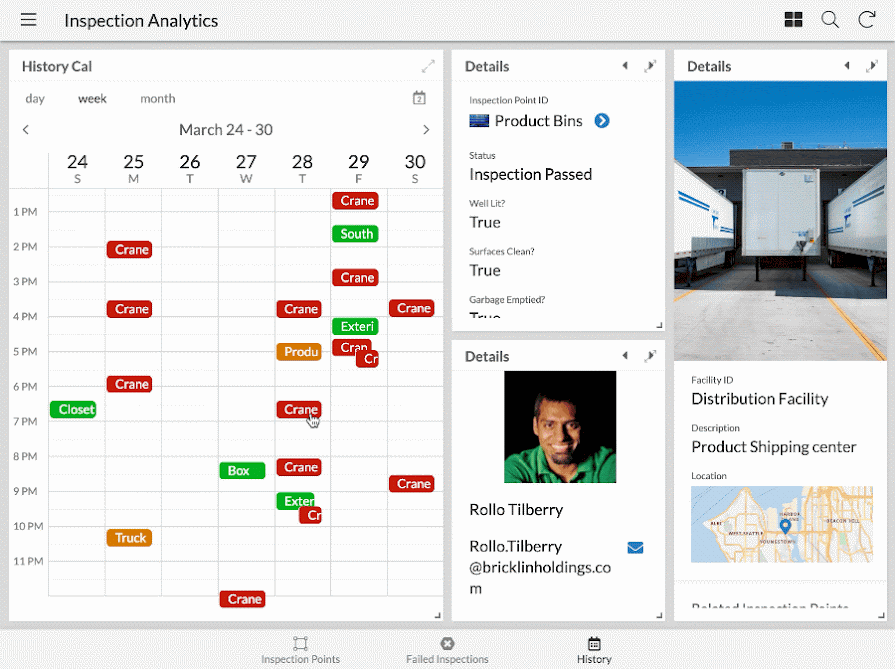
via Google AppSheet
AppSheet integrates with Google Workspace, allowing teams to turn Sheets data into mobile-ready apps without writing code. Drag-and-drop expressions handle business logic, while role-based permissions pull directly from Google accounts, reducing IT involvement.
Once deployed, team members capture field data, approve requests, and trigger Drive or Gmail automations from any device. And because everything is stored in BigQuery or Sheets, analysts can keep their existing reporting pipelines intact, rather than rebuilding them around a new tool.
Google AppSheet best features
- Build apps with an intuitive no-code platform that empowers non-technical users to create custom applications rapidly
- Automate workflows and business processes with event-driven bots, scheduled automations, and conditional logic
- Customize user interfaces with dynamic views (tables, forms, maps, charts, calendars) and custom branding options to match your needs and aesthetics
Google AppSheet limitations
- The desktop view version is relatively restrictive compared to the mobile-app/tablet view
- Limited formatting configuration options
Google AppSheet pricing
- Starter: $5/month per user
- Core: $10/month per user
- Enterprise Plus: $20/month per user
Google AppSheet ratings and reviews
- G2: 4.8/5 (390+ reviews)
- Capterra: 4.7/5 (500+ reviews)
What are real-life users saying about Google AppSheet?
This is how one user described their experience:
💡 Pro Tip: Create reference fields, not just text fields. Instead of entering a project name manually, create a reference field to another table; this ensures data integrity and allows lookups and rollups down the line.
3. Microsoft SQL Server (Best for enterprise-level relational database management)
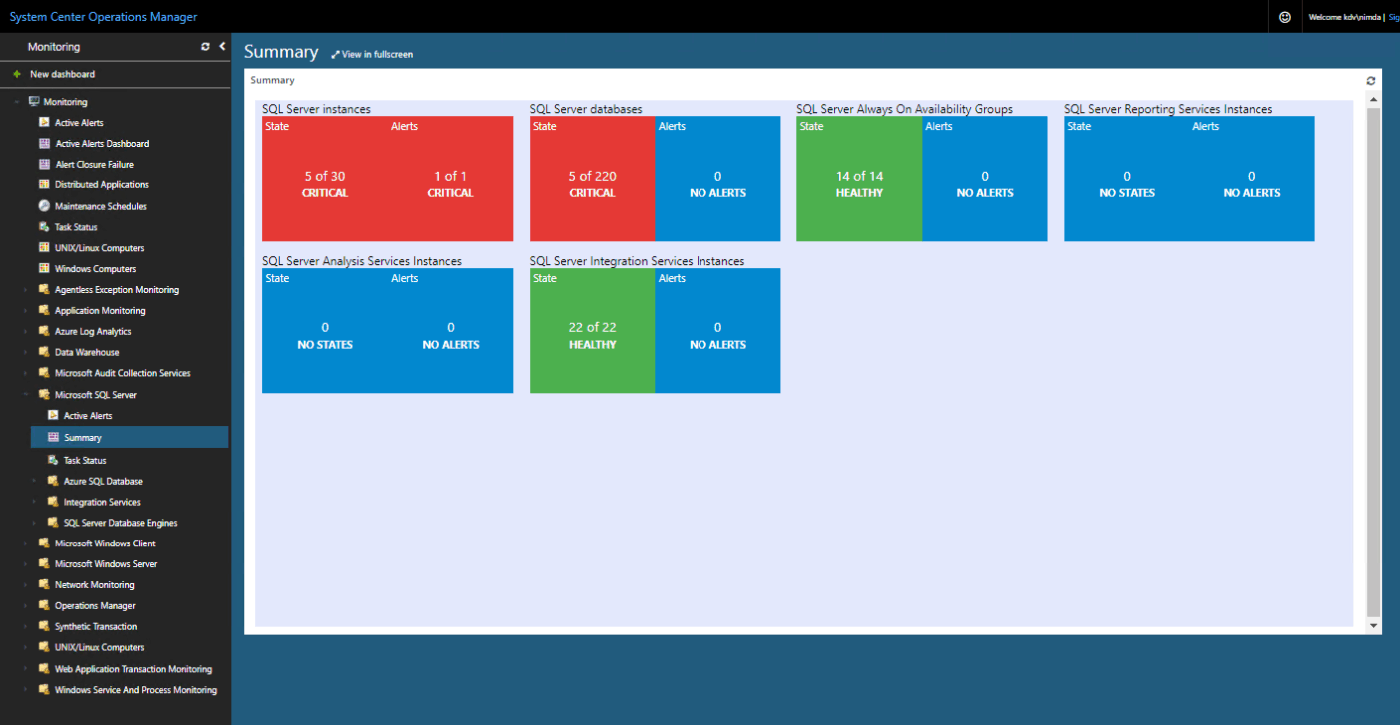
SQL Server offers a mature RDBMS, along with integrated tooling, that enables developers to focus on schema design and query tuning, rather than infrastructure plumbing. T-SQL supports complex joins and window functions, while columnstore indexes and in-memory OLTP handle sizable transactional loads.
Built-in JSON and graph extensions keep modern data types in the same engine, simplifying tech stacks. DevOps pipelines slot in through native Docker images and the SQL Server Data Tools extension. Automated unit tests validate stored procedures, and Query Store surfaces regressions before they reach production.
Microsoft SQL Server best features
- Keep systems responsive without manual failovers or downtime windows with the Always On Availability and online index rebuilds
- Enforce robust data security through transparent data encryption, row-level security, and comprehensive auditing capabilities
- Integrate seamlessly with the broader Microsoft ecosystem, leveraging tools like SQL Server Integration Services (SSIS) for ETL, SQL Profiler for performance tuning, and Management Studio for administration
Microsoft SQL Server limitations
- It’s not easy to fault-find at times, with limited tools, due to the complexity of some databases
- CSV importing is complicated
Microsoft SQL Server pricing
- Custom pricing
Microsoft SQL Server ratings and reviews
- G2: 4.5/5 (2,200+ reviews)
- Capterra: 4.6/5 (1,900+ reviews)
What are real-life users saying about Microsoft SQL Server?
One Capterra review puts it this way:
4. Microsoft Access (Best for desktop database creation and local use)
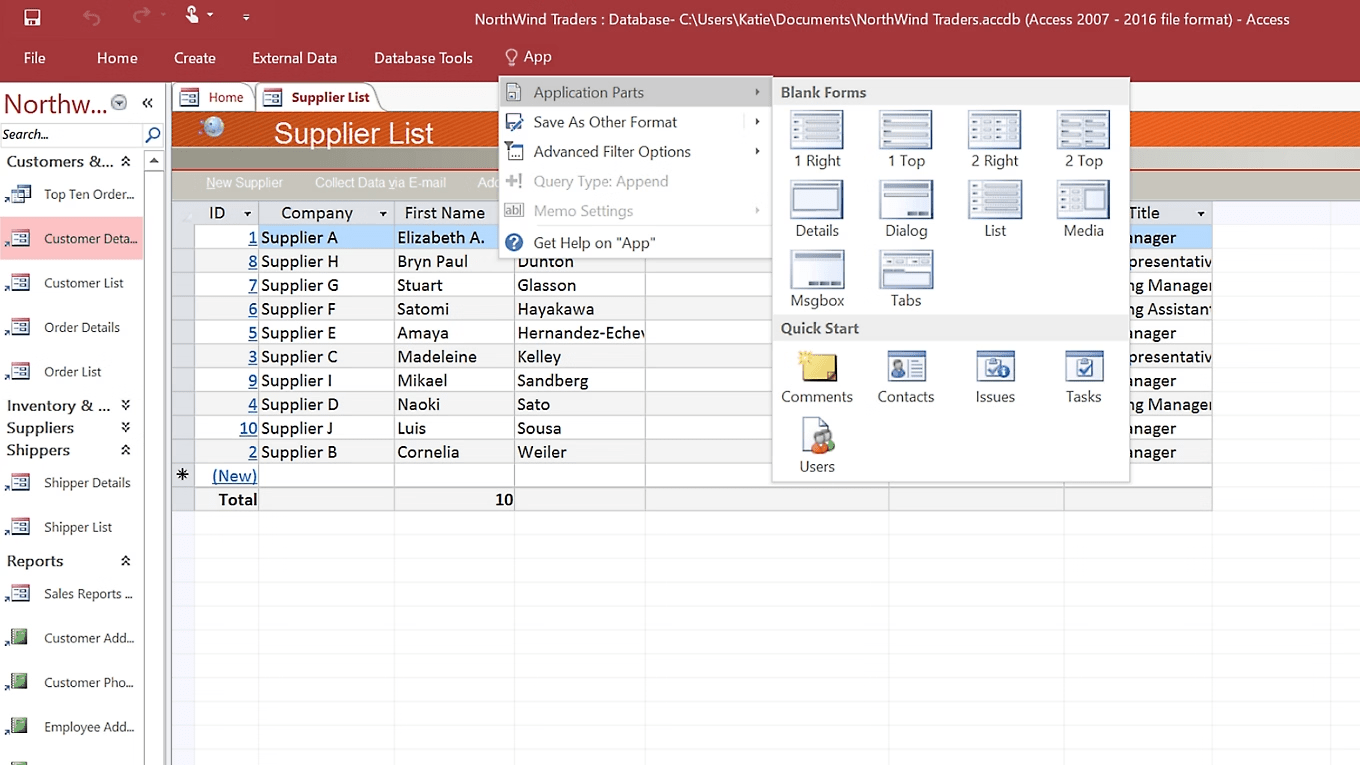
via Microsoft Access
Microsoft Access helps operations managers centralize scattered spreadsheets into a single desktop database without hiring a DBA. Table wizards import CSVs, invoices, or equipment logs in minutes, and the Relationships view makes entity links visible at a glance.
You can run routine tasks, like monthly variance checks, through saved queries and macros. Additionally, because Access syncs with SharePoint or SQL Server, you can start locally and later migrate data online without needing to rewrite processes.
Microsoft Access best features
- Design and manage relational databases with tables, forms, queries, and reports without technical expertise
- Automate repetitive tasks and business logic with built-in macros and Visual Basic for Applications (VBA)
- Import and export data easily from and to various formats (Excel database, CSV, XML), and link to external data sources
- Control user access and data integrity through role-based permissions, data validation rules, and referential integrity enforcement
Microsoft Access limitations
- Users complain that it seems a bit outdated
- It lacks advancements and updates compared to Microsoft Access alternatives
Microsoft Access pricing
- Access: $179.99/user
Microsoft Access ratings and reviews
- G2: 4.5/5 (800+ reviews)
- Capterra: 4.5/5 (200+ reviews)
What are real-life users saying about Microsoft Access?
A user shared this feedback:
💡 Pro Tip: Use a single-select field named _OwnerCheck in every table, and filter ‘My Tasks’ views based on it. This enforces clear ownership, prevents orphaned records, and keeps task accountability front and center.
5. Zoho Creator (Best for building scalable business apps quickly)
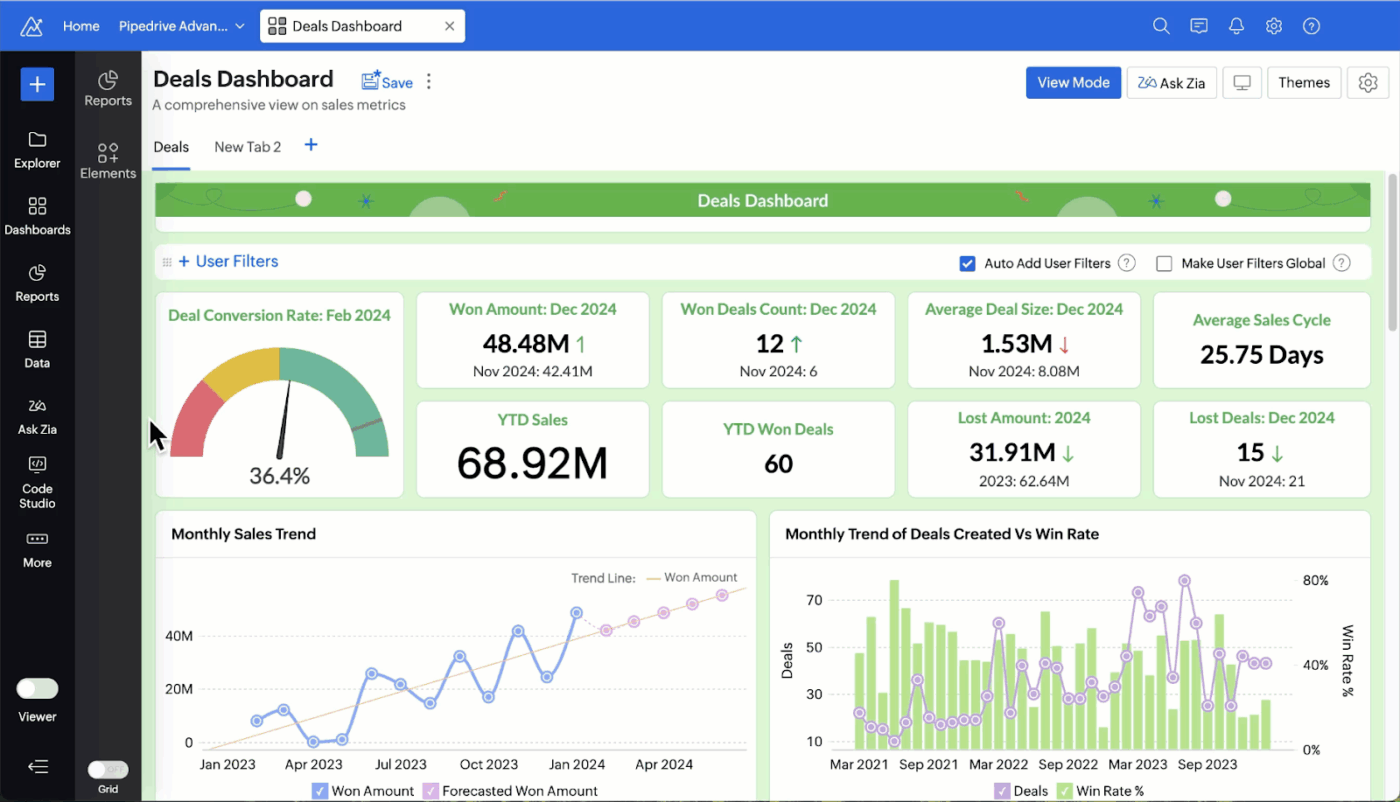
via Zoho Creator
Zoho Creator lets marketing teams spin up campaign trackers, lead routers, and content calendars without waiting on engineering sprints. Its Deluge scripting language resembles plain English and plugs directly into Zoho CRM, Google Ads, and Facebook Lead Ads, keeping attribution and ROI metrics in one place.
Plus, custom workflows send nurture emails or Slack alerts when prospects cross score thresholds. You can also use embedded analytics to reveal channel performance down to the creative variant. Marketers gain a self-service hub that scales as funnels evolve, without brittle sheets or one-off SaaS silos.
Zoho Creator best features
- Automate business processes with a powerful workflow engine, enabling approvals, notifications, and data processing
- Deploy applications instantly across web, iOS, and Android platforms, with seamless offline data access
- Integrate with Zoho’s suite and third-party services, supporting analytics, real-time collaboration, and customer portals
Zoho Creator limitations
- Users struggle with building complex software
- A lot of the template wizards are aimed at solutions only for the United States, limiting access
Zoho Creator pricing
- Free trial available
- Standard: $12/month per user
- Professional: $230/month per user
- Enterprise: $37/month per user
Zoho Creator ratings and reviews
- G2: 4.6/5 (150+ reviews)
- Capterra: 4.6/5 (160+ reviews)
What are real-life users saying about Zoho Creator?
Straight from a G2 review:
6. Knack (Best for building simple online databases without code)
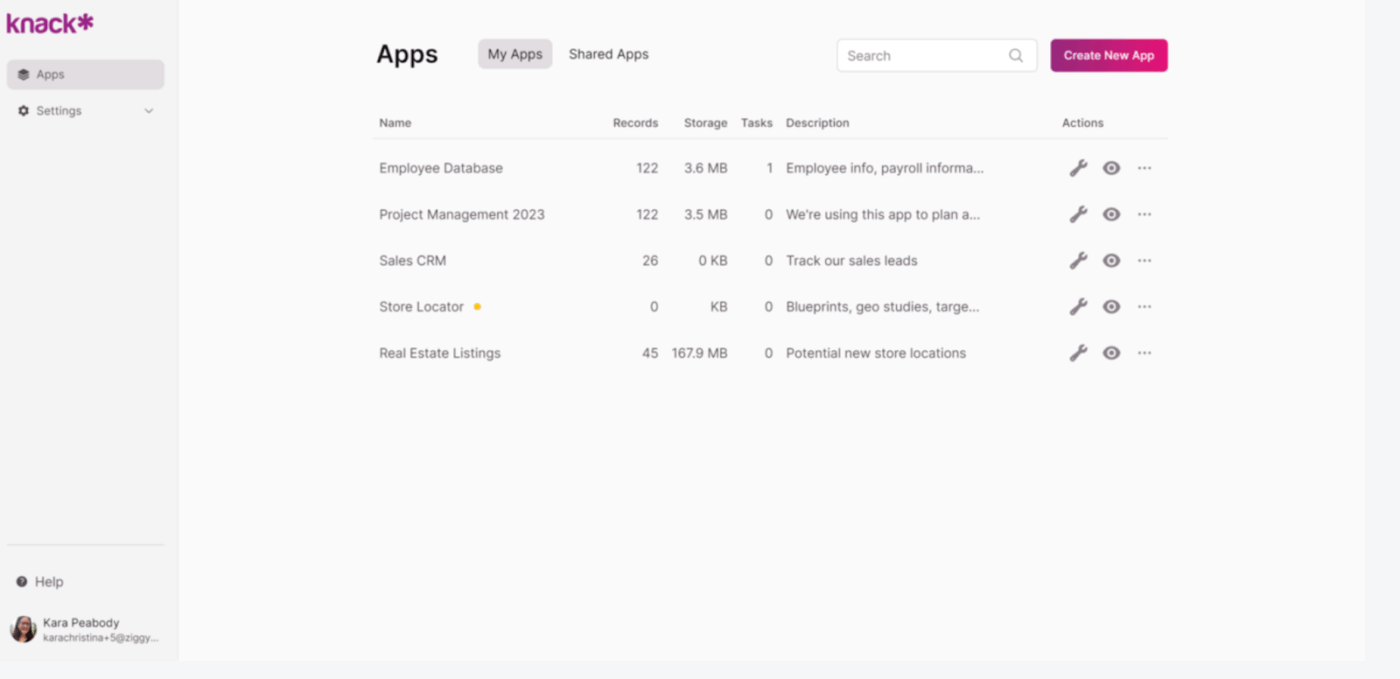
via Knack
Knack provides a browser-based builder where teams can map out tables, define connections, and generate responsive interfaces all within the same canvas. Pre-built database templates jump-start common use cases, such as asset logs, client portals, and volunteer rosters, so setup time is measured in hours.
The rules engine filters views based on user roles, so each stakeholder only sees what’s relevant to them. For integrations, API endpoints make it easy to access and connect any object, while tools like Zapier or Make can handle quick automations without coding. Since hosting, backups, and SSL security are included, teams can skip the hassle of managing servers or configuring firewalls—yet still retain full control over their data model.
Knack best features
- Visualize data with built-in charts, calendars, maps, and tables, making it easy to analyze
- Embed apps into websites or portals, providing a white-labeled experience and extending functionality
- Design intuitive interfaces with a WYSIWYG editor and customizable branding options
- Collaborate and manage content with document and content management tools
Knack limitations
- Users complain that it’s a dated-looking web app that needs to be more flexible in design
- No adequate cookie documentation, which is problematic for GDPR statements
Knack pricing
- Starter: $19/month per user
- Pro: $49/month per user
- Corporate: Starting at $269
- Enterprise: Custom pricing
Knack ratings and reviews
- G2: 4.6/5 (100+ reviews)
- Capterra: 4.5/5 (90+ reviews)
What are real-life users saying about Knack?
See what this reviewer had to say:
💡 Pro Tip: Always create a custom _ID field using a formula like RecordType + ‘-‘ + RANDOM_STRING(6). Even if your platform auto-generates record IDs, this makes integrations, reporting, and filtering more human-readable and dependable.
Use ClickUp Brain MAX to capture and clean data instantly
Manual data entry is one of the biggest productivity killers when managing shared databases. That’s where ClickUp Brain MAX comes in—ClickUp’s desktop AI assistant that lets you update or create records hands-free with Talk to Text.
Instead of switching tabs or typing every field, you can speak updates like “Add a new client to the database with priority = high and due date = Friday,” and ClickUp Brain MAX will instantly convert it into a task or record.
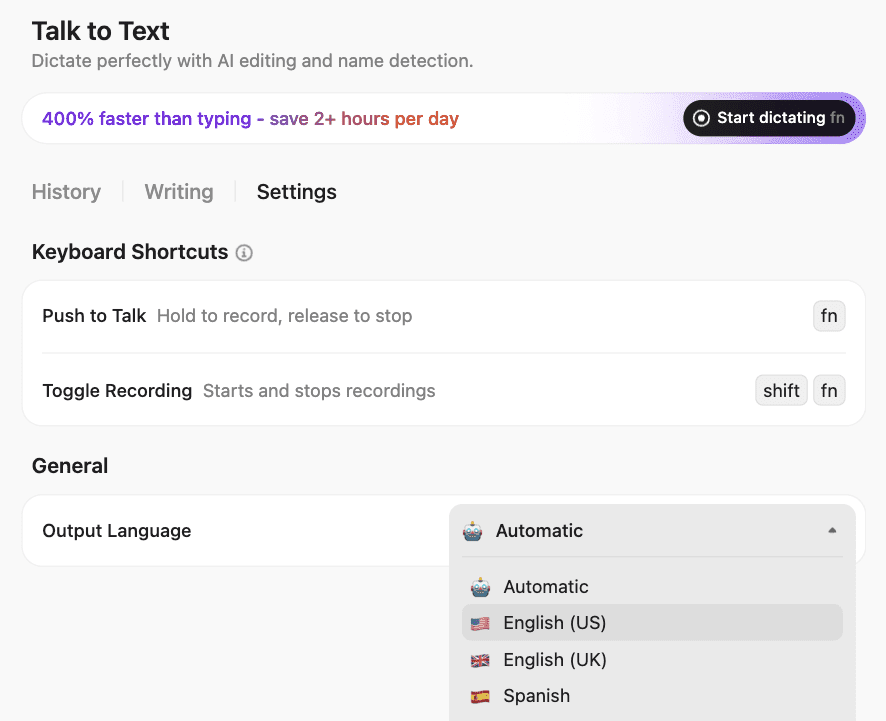
Once captured, ClickUp Brain (in-app) can summarize your latest project entries, detect duplicate records, and even generate quick insights across related data. Together, they turn your workspace into an intelligent, self-maintaining database—so your team spends less time fixing data and more time using it.
💫 Think of it as your voice-powered database assistant that keeps every field, task, and report in perfect sync.
7. Caspio (Best for low-code app development with enterprise compliance)
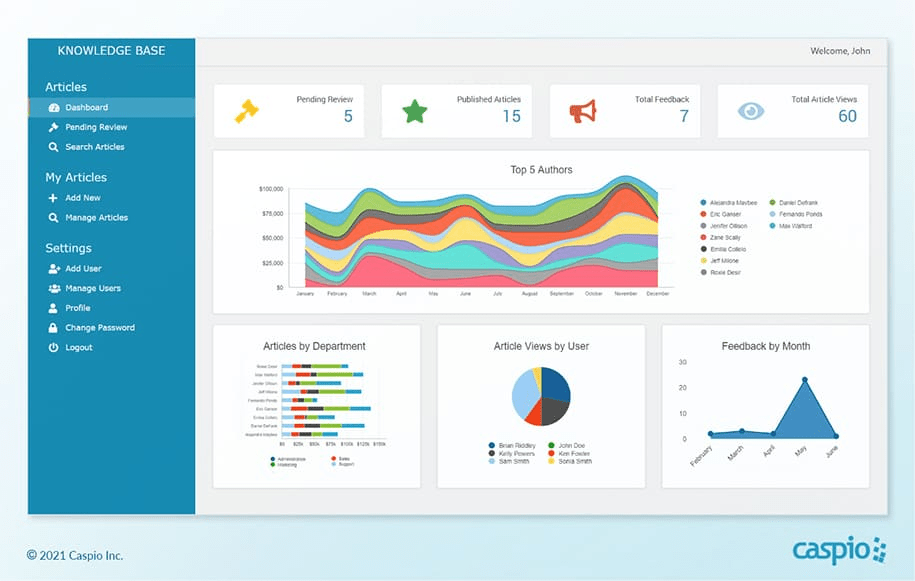
via Caspio
Caspio is built for operations leaders who need governance-ready web apps. Everything lives in a secure, SOC 2- and HIPAA-compliant cloud, making audits significantly less painful. You can build with point-and-click triggers that handle field-level validations (no SQL needed), but if you’re more technical, you can drop into JavaScript or plug into REST APIs.
Need structured workflows? The database design tool’s multi-step automation can route service tickets or quality checks through a chain of approvers, while granular logs track every change, so you’re always audit-ready.
Caspio best features
- Leverage AI-powered data capabilities with integrated OpenAI ChatGPT to generate insights
- Customize app interfaces with flexible frameworks like Flex and Bridge
- Manage data securely on robust AWS and Microsoft SQL infrastructure for high reliability
Caspio limitations
- It offers complex customizations, but you can’t add code or more design features
- Import isn’t available based on the trigger
Caspio pricing
- Lite: $100/month
- Plus: $300/month
- Business: $600/month
- Enterprise: Custom pricing
Caspio ratings and reviews
- G2: 4.5/5 (150 reviews)
- Capterra: 4.5/5 (200+ reviews)
What are real-life users saying about Caspio?
Straight from a Capterra review:
🔍 Did You Know? Graph databases, built on graph theory and ideal for mapping relationships, originated in 2006, inspired by Tim Berners-Lee’s vision for linked data.
8. Zapier (Best automation platform for connecting apps and workflows)
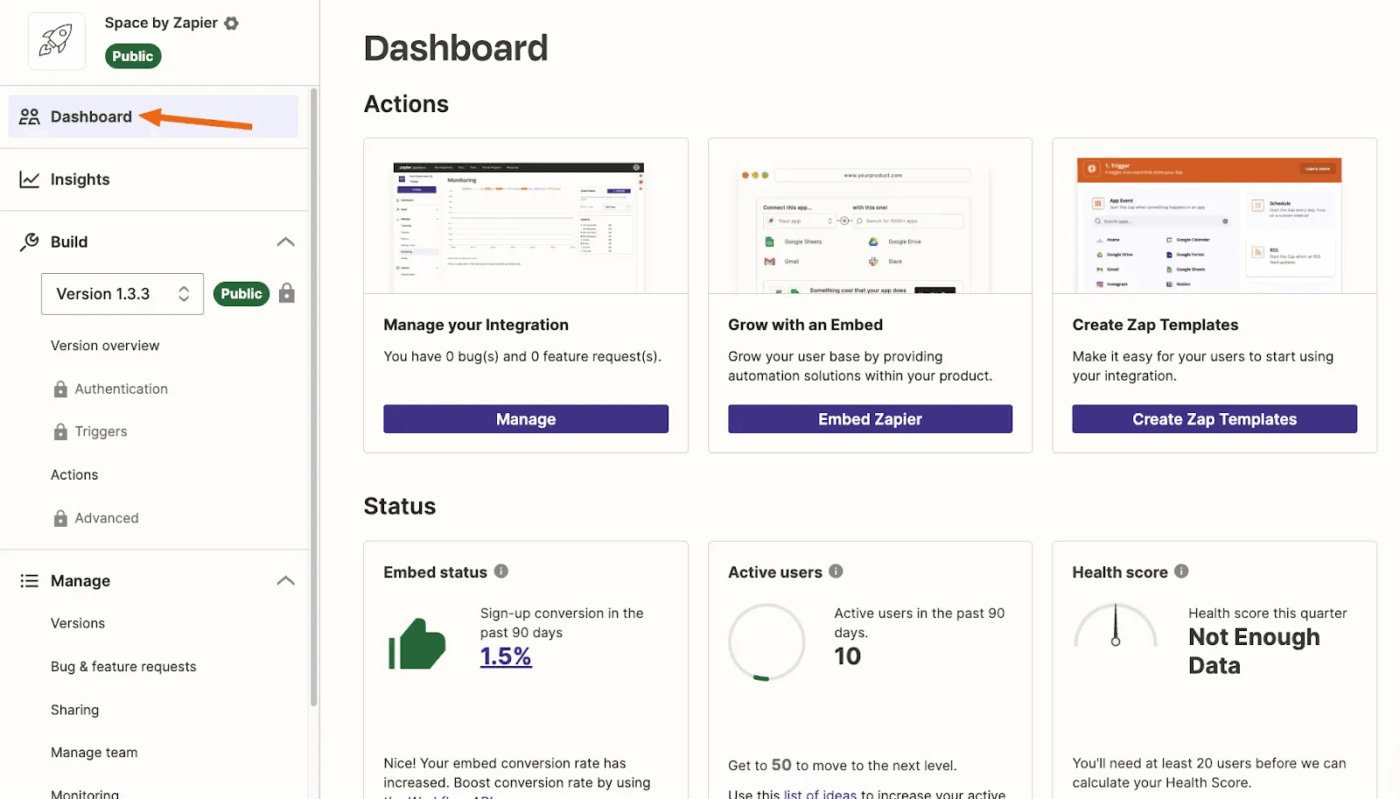
via Zapier
Zapier connects over 6,000 SaaS apps through Zaps, allowing marketers to stitch together campaigns without writing middleware. A trigger (such as form fill, purchase, or webinar registration) initiates step-by-step actions, including updating CRM fields or sending nurture emails.
Path rules enable you to branch flows based on lead score, UTM source, or other key fields, ensuring the right contacts receive the right treatment. And if something goes wrong? Error handling automatically retries failed runs and alerts the owner, reducing the likelihood of silent failures.
Zapier best features
- Build multi-step workflows that can include filters, delays, and conditional logic
- Monitor and manage automation history with detailed logs and error tracking
- Let built-in formatters take care of cleanup tasks
Zapier limitations
- Some integrations feel incomplete or unstable. For example, not all apps have triggers or actions that truly leverage their API
- Sometimes, the different Zaps can break and impact workflows
Zapier pricing
- Free forever
- Professional: $29.99/month
- Team: $103.50/month
- Enterprise: Custom pricing
Zapier ratings and reviews
- G2: 4.5/5 (1,300+ reviews)
- Capterra: 4.7/5 (3,000+ reviews)
What are real-life users saying about Zapier?
A G2 review puts it this way:
9. Tadabase (Best for building complex, data-driven web apps)
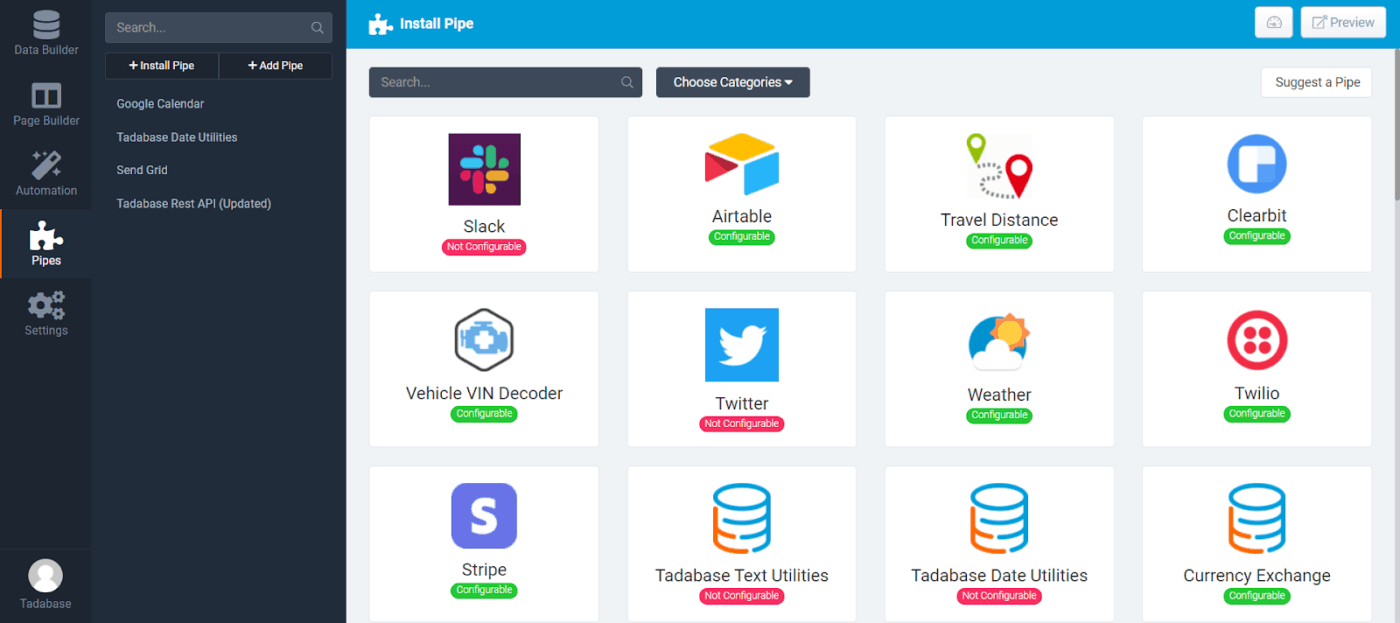
via Tadabase
Tadabase excels at building internal tools that mirror complex processes, such as multi-table manufacturing trackers, field-service dispatchers, and HR onboarding portals. The schema designer handles many-to-many links, and component-based layouts display related records side by side for quick context.
Automations execute on schedule or in response to an event, with native support for PDF generation and email steps. Self-host or deploy to Tadabase’s managed cloud; both options include role-based access controls and audit logs. You can also replace legacy Access files or outdated intranet forms with a secure, browser-based system that adapts to changing policies.
Tadabase best features
- Visualize and manage data with Kanban boards, calendars, maps, charts, and interactive tables
- Extend app capabilities with custom CSS, JavaScript, and build custom components
- Deploy instant updates and tweaks with zero downtime
Tadabase limitations
- Lacks advanced features in comparison to other relational database software
- Initial setup is time-consuming
Tadabase pricing
- Starter: $50/month per user
- Growth: $125/month per user
- Professional: $250/month per user
- Elite: $450/month per user
Tadabase ratings and reviews
- G2: Not enough reviews
- Capterra: 4.9/5 (20+ reviews)
What are real-life users saying about Tadabase?
Here’s what one reviewer has to say:
💡 Pro Tip: Build a CRM database with a ‘lookup rollup’ field to count related child records. For example, in a client table, display the number of active projects by rolling up from the Project table, where the Status is not Complete. ‘Great for capacity planning and prioritization.
10. PostgreSQL (Best open-source relational database for advanced SQL use)
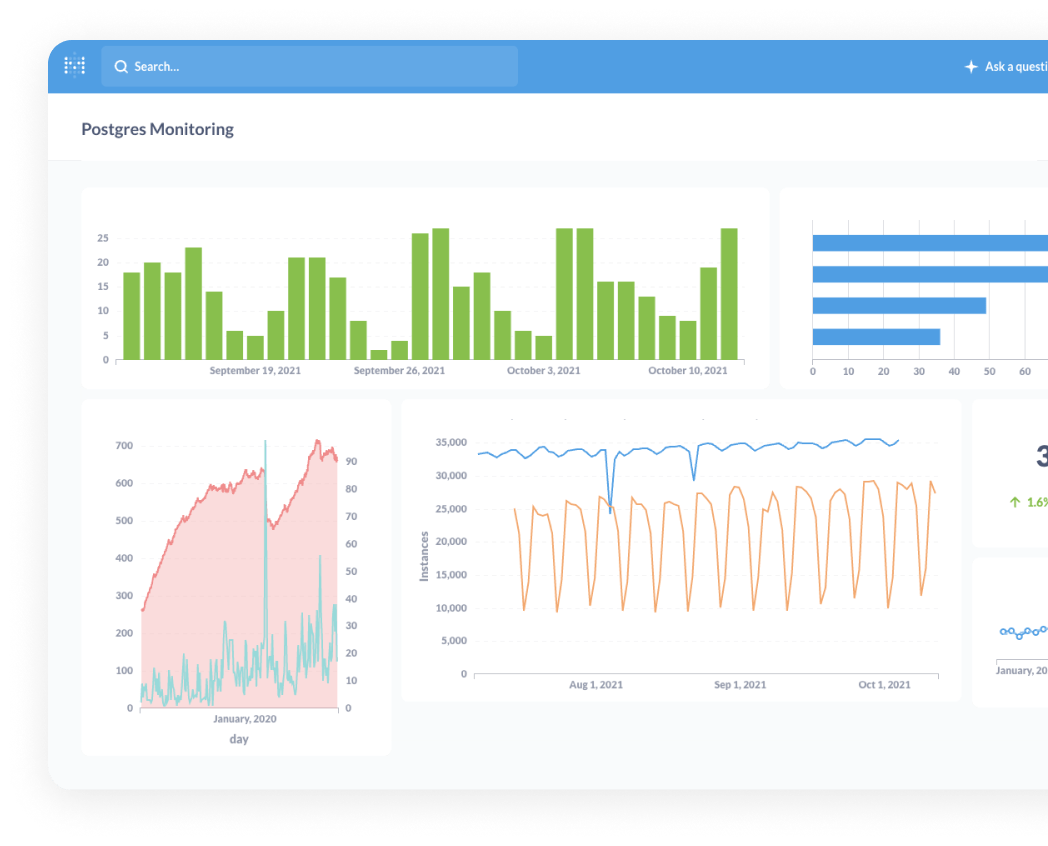
via PostgreSQL
PostgreSQL gives developers a powerful, extensible SQL engine they can prototype with locally and scale to terabytes without changing syntax. With support for rich data types, such as JSONB, arrays, and PostGIS geometry, there’s often no need to juggle multiple databases to handle diverse workloads.
Built-in features, such as declarative partitioning and logical replication, cover everything from analytics to high-availability setups. Tools like PGAdmin, psql, and a broad driver ecosystem plug seamlessly into CI pipelines, making integration smooth.
PostgreSQL best features
- Support advanced data types and extensibility, including custom types, arrays, and powerful JSON/JSONB handling
- Add extensions like pg_partman or TimescaleDB for advanced partitioning or time-series capabilities
- Deliver enterprise-grade scalability with multi-version concurrency control (MVCC), point-in-time recovery, streaming replication, and high-availability architectures
- Optimize performance at scale using advanced indexing (B-tree, GIN, GiST), partitioning, and parallel query execution
PostgreSQL limitations
- It offers fewer GUI tools compared to other databases
- Lacks extensions with widely used open-source software/apps
PostgreSQL pricing
- Custom pricing
PostgreSQL ratings and reviews
- G2: 4.5/5 (600+ reviews)
- Capterra: 4.6/5 (400+ reviews)
What are real-life users saying about PostgreSQL?
A quick snippet from a real user:
11. Airtable (Best for blending spreadsheets with relational databases)
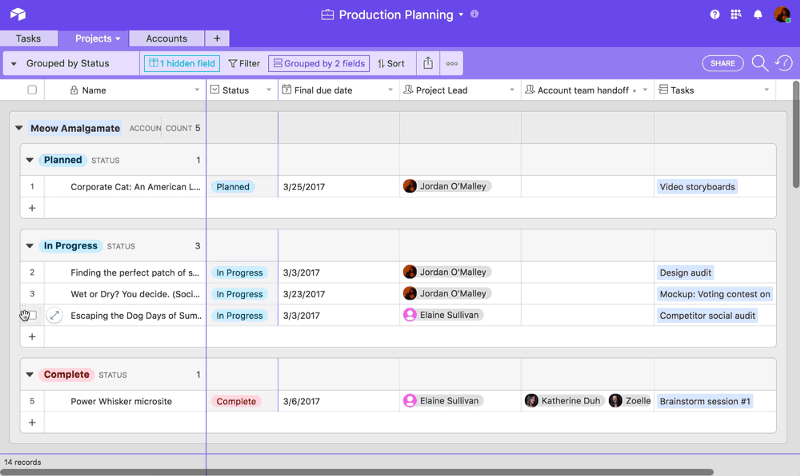
via Airtable
Airtable gives product teams a single workspace to plan roadmaps, gather user feedback, and manage releases. You can pivot, group, or calendar your data with just a few clicks without formulas. Each record supports file uploads, rich text, and checklists, making it easy for designers, engineers, and PMs to collaborate in one place.
And with Interfaces, you can turn complex spreadsheet project management into clean, lightweight dashboards that give execs the high-level view they need.
Airtable best features
- Visualize data with built-in reporting and dashboards to track project progress, budgets, and success metrics
- Use Airtable AI to enhance data organization, generate insights, and support decision-making
- Access extensive resources, customer stories, and expert insights to stay ahead of industry trends
Airtable limitations
- The database builder software is too simple for complex workflows, lacking flexibility and advanced charting options
- It’s harder to run complex queries/summaries on numerical data across the database
Airtable pricing
- Free
- Team: $20/month per user (annually)
- Business: $45/month per user
- Enterprise: Custom pricing
Airtable ratings and reviews
- G2: 4.6/5 (2,940+ reviews)
- Capterra: 4.7/5 (2,100+ reviews)
What are real-life users saying about Airtable?
According to one reviewer:
Build a Strong (Data) Base With ClickUp
Now that we’ve gone over the best database builder software out there, you know that he right fit depends on your team’s skill level, the complexity of your use case, and the level of flexibility you require.
If you need more than just a database, turn to ClickUp. The no-code tool lets you build custom views, connect fields, organize unstructured data, and collaborate in real time with multiple users.
Sign up to ClickUp for free today! ✅

